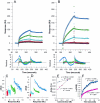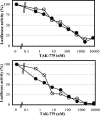Interaction with CD4 and antibodies to CD4-induced epitopes of the envelope gp120 from a microglial cell-adapted human immunodeficiency virus type 1 isolate
- PMID: 15890908
- PMCID: PMC1112147
- DOI: 10.1128/JVI.79.11.6703-6713.2005
Interaction with CD4 and antibodies to CD4-induced epitopes of the envelope gp120 from a microglial cell-adapted human immunodeficiency virus type 1 isolate
Abstract
We previously showed that the envelope glycoprotein from an in vitro microglia-adapted human immunodeficiency virus type 1 isolate (HIV-1(Bori-15)) is able to use lower levels of CD4 for infection and demonstrates greater exposure of the CD4-induced epitope recognized by the 17b monoclonal antibody than the envelope of its parental, peripheral isolate (HIV-1(Bori)). We investigated whether these phenotypic changes were related to a different interaction of their soluble monomeric gp120 proteins with CD4 or 17b. Equilibrium binding analyses showed no difference between Bori and Bori-15 gp120s. However, kinetic analysis of surface plasmon resonance-based, real-time binding experiments showed that while both proteins have similar association rates, Bori-15 gp120 has a statistically significant, 3-fold-lower dissociation rate from immobilized CD4 than Bori and a statistically significant, 14-fold-lower dissociation rate from 17b than Bori in the absence of soluble CD4. In addition, using the sensitivity to inhibition by anti-CD4 antibodies as a surrogate for CD4:trimeric envelope interaction, we found that Bori-15 envelope-pseudotyped viruses were significantly less sensitive than Bori pseudotypes, with four- to sixfold-higher 50% inhibitory concentration values for the three anti-CD4 antibodies tested. These differences, though small, suggest that adaptation to microglia correlates with the generation of a gp120 that forms a more stable interaction with CD4. Nonetheless, the observation of limited binding changes leaves open the possibility that HIV-1 adaptation to microglia and HIV-associated dementia may be related not only to diminished CD4 dependence but also to changes in other molecular factors involved in the infection process.
Figures





Similar articles
-
Differential CD4/CCR5 utilization, gp120 conformation, and neutralization sensitivity between envelopes from a microglia-adapted human immunodeficiency virus type 1 and its parental isolate.J Virol. 2001 Apr;75(8):3568-80. doi: 10.1128/JVI.75.8.3568-3580.2001. J Virol. 2001. PMID: 11264346 Free PMC article.
-
Conformational changes of gp120 in epitopes near the CCR5 binding site are induced by CD4 and a CD4 miniprotein mimetic.Biochemistry. 1999 Jul 20;38(29):9405-16. doi: 10.1021/bi990654o. Biochemistry. 1999. PMID: 10413516
-
Determinants of syncytium formation in microglia by human immunodeficiency virus type 1: role of the V1/V2 domains.J Virol. 2000 Jan;74(2):693-701. doi: 10.1128/jvi.74.2.693-701.2000. J Virol. 2000. PMID: 10623731 Free PMC article.
-
CD4 activation of HIV fusion.Int J Cell Cloning. 1992 Nov;10(6):323-32. doi: 10.1002/stem.5530100603. Int J Cell Cloning. 1992. PMID: 1281202 Review.
-
HIV-1 gp120: a novel viral B cell superantigen.Int Rev Immunol. 1997;14(4):325-38. doi: 10.3109/08830189709116523. Int Rev Immunol. 1997. PMID: 9186784 Review.
Cited by
-
Transcriptional activity of blood-and cerebrospinal fluid-derived nef/long-terminal repeat sequences isolated from a slow progressor infected with nef-deleted human immunodeficiency virus type 1 (HIV-1) who developed HIV-associated dementia.J Neurovirol. 2006 Jun;12(3):219-28. doi: 10.1080/13550280600827369. J Neurovirol. 2006. PMID: 16877303
-
Broad-spectrum anti-human immunodeficiency virus (HIV) potential of a peptide HIV type 1 entry inhibitor.J Virol. 2007 Apr;81(7):3645-8. doi: 10.1128/JVI.01778-06. Epub 2007 Jan 24. J Virol. 2007. PMID: 17251295 Free PMC article.
-
The V1-V3 region of a brain-derived HIV-1 envelope glycoprotein determines macrophage tropism, low CD4 dependence, increased fusogenicity and altered sensitivity to entry inhibitors.Retrovirology. 2008 Oct 6;5:89. doi: 10.1186/1742-4690-5-89. Retrovirology. 2008. PMID: 18837996 Free PMC article.
-
The HIV Env variant N283 enhances macrophage tropism and is associated with brain infection and dementia.Proc Natl Acad Sci U S A. 2006 Oct 10;103(41):15160-5. doi: 10.1073/pnas.0605513103. Epub 2006 Oct 2. Proc Natl Acad Sci U S A. 2006. PMID: 17015824 Free PMC article.
-
Fate of microglia during HIV-1 infection: From activation to senescence?Glia. 2017 Mar;65(3):431-446. doi: 10.1002/glia.23081. Epub 2016 Nov 26. Glia. 2017. PMID: 27888531 Free PMC article. Review.
References
-
- Albright, A. V., J. T. Shieh, T. Itoh, B. Lee, D. Pleasure, M. J. O'Connor, R. W. Doms, and F. González-Scarano. 1999. Microglia express CCR5, CXCR4, and CCR3, but of these, CCR5 is the principal coreceptor for human immunodeficiency virus type 1 dementia isolates. J. Virol. 73:205-213. - PMC - PubMed
-
- Baba, M., O. Nishimura, N. Kanzaki, M. Okamoto, H. Sawada, Y. Iizawa, M. Shiraishi, Y. Aramaki, K. Okonogi, Y. Ogawa, K. Meguro, and M. Fujino. 1999. A small-molecule, nonpeptide CCR5 antagonist with highly potent and selective anti-HIV-1 activity. Proc. Natl. Acad. Sci. USA 96:5698-5703. - PMC - PubMed
-
- Bosch, M. L., P. L. Earl, K. Fargnoli, S. Picciafuoco, F. Giombini, F. Wong-Staal, and G. Franchini. 1989. Identification of the fusion peptide of primate immunodeficiency viruses. Science 244:694-697. - PubMed
-
- Brigham-Burke, M., J. R. Edwards, and D. J. O'Shannessy. 1992. Detection of receptor-ligand interactions using surface plasmon resonance: model studies employing the HIV-1 gp120/CD4 interaction. Anal. Biochem. 205:125-131. - PubMed
Publication types
MeSH terms
Substances
Grants and funding
LinkOut - more resources
Full Text Sources
Other Literature Sources
Research Materials

